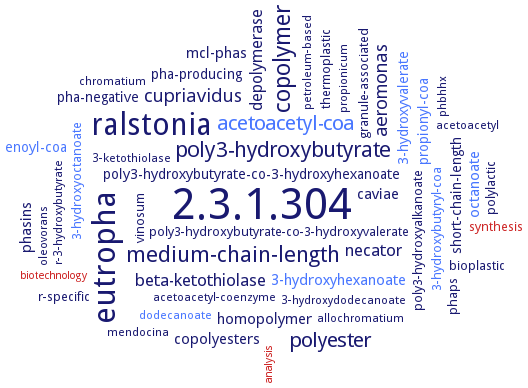2.3.1.304: poly[(R)-3-hydroxyalkanoate] polymerase
This is an abbreviated version!
For detailed information about poly[(R)-3-hydroxyalkanoate] polymerase, go to the full flat file.

Word Map on EC 2.3.1.304 
-
2.3.1.304
-
eutropha
-
ralstonia
-
copolymer
-
medium-chain-length
-
poly3-hydroxybutyrate
-
polyester
-
acetoacetyl-coa
-
aeromonas
-
cupriavidus
-
necator
-
beta-ketothiolase
-
depolymerase
-
3-hydroxyhexanoate
-
phasins
-
mcl-phas
-
octanoate
-
homopolymer
-
copolyesters
-
caviae
-
3-hydroxyvalerate
-
propionyl-coa
-
pha-producing
-
poly3-hydroxybutyrate-co-3-hydroxyhexanoate
-
short-chain-length
-
pha-negative
-
enoyl-coa
-
synthesis
-
3-hydroxyoctanoate
-
3-hydroxybutyryl-coa
-
poly3-hydroxyalkanoate
-
granule-associated
-
phaps
-
polylactic
-
bioplastic
-
vinosum
-
r-specific
-
poly3-hydroxybutyrate-co-3-hydroxyvalerate
-
thermoplastic
-
petroleum-based
-
acetoacetyl
-
acetoacetyl-coenzyme
-
propionicum
-
chromatium
-
dodecanoate
-
phbhhx
-
mendocina
-
oleovorans
-
allochromatium
-
3-ketothiolase
-
r-3-hydroxybutyrate
-
3-hydroxydodecanoate
-
biotechnology
-
analysis
- 2.3.1.304
-
eutropha
-
ralstonia
-
copolymer
-
medium-chain-length
-
poly3-hydroxybutyrate
-
polyester
- acetoacetyl-coa
-
aeromonas
-
cupriavidus
-
necator
- beta-ketothiolase
-
depolymerase
- 3-hydroxyhexanoate
-
phasins
-
mcl-phas
- octanoate
-
homopolymer
-
copolyesters
-
caviae
- 3-hydroxyvalerate
- propionyl-coa
-
pha-producing
-
poly3-hydroxybutyrate-co-3-hydroxyhexanoate
-
short-chain-length
-
pha-negative
- enoyl-coa
- synthesis
- 3-hydroxyoctanoate
- 3-hydroxybutyryl-coa
-
poly3-hydroxyalkanoate
-
granule-associated
-
phaps
-
polylactic
-
bioplastic
-
vinosum
-
r-specific
-
poly3-hydroxybutyrate-co-3-hydroxyvalerate
-
thermoplastic
-
petroleum-based
-
acetoacetyl
-
acetoacetyl-coenzyme
-
propionicum
-
chromatium
- dodecanoate
-
phbhhx
-
mendocina
-
oleovorans
-
allochromatium
- 3-ketothiolase
-
r-3-hydroxybutyrate
-
3-hydroxydodecanoate
- biotechnology
- analysis
Reaction
Synonyms
BP-M-CPF4, broad-range class I PhaCAc, CLAOCE_21140, CLAOCE_21150, CLAOCE_21150/21140, class I PHA synthase, Class I PhaC, class I PhaCRe, class I PHB synthase, Class I poly(R)-hydroxyalkanoic acid synthase, class I polyhydroxyalkanoate synthase, class I polyhydroxybutyrate synthase, Class I synthase, Class II PHA polymerizing enzyme, class II PHA synthase, Class II PhaC, class II PhaC1, class III PHA synthase, class III PHB synthase, class III polyhydroxyalkanoate synthase, class III polyhydroxybutyrate synthase, class III synthase, class IV PHA synthase, H16_A1437, HPTL0263, HPTL0635, HPTL1376, intracellular polyhydroxyalkanoate synthase, P(3HB) synthase, PHA polymerase, PHA synthase, PHA synthase 1, PHA synthase I, PHA synthase II, PHA synthase III, PhaC, PhaC type II, PhaC-II, PhaC1, PhaC1P-5, PhaC1Pp, PhaC1Ps, PhaC1SG, PhaC2, PhaC2P-5, PhaC2Ps, PhaC2SG, PhaCAc, PhaCAv, phaCBP-M-CPF4, PhaCCc, PhaCCn-CAT, PhaCCs, PhaCCs-CAT, phaCCv, PhaCPhaEAv, PhaCRe, PhaE, PhaEC, PhaECAv, PhaRCBm, PhaRCYB4, PHB synthase, PhbC, PhbCRe, phbC_2, phbE, poly(3-hydroxybutyrate) synthase, poly(hydroxyalkanoic acid) synthase, poly-3-hydroxybutyrate synthase, poly-beta-hydroxybutyrate synthase, polyhydroxyalkanoate (PHA) synthase, polyhydroxyalkanoate synthase, polyhydroxyalkanoate synthase 1, polyhydroxyalkanoate synthase synthase, polyhydroxyalkanoic acids synthase, polyhydroxyalkanoic synthase I, polyhydroxyalkanoic synthase II, polyhydroxyalkanoic synthase III, polyhydroxybutyrate synthase, Q667_12980, TH-1_PHB synthase_HPTL_0263, TH-1_PHB synthase_HPTL_0635, TH-1_PHB synthase_HPTL_1376, type I PHA synthase, type I polyhydroxyalkanoate synthase, type II PHA synthase, type II PhaC1, type II polyhydroxyalkanoate synthase, type II Pseudomonas PHA synthase 1, type III PHA synthase, type-III PHA synthase, YdcS


 results (
results ( results (
results ( top
top






